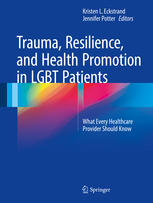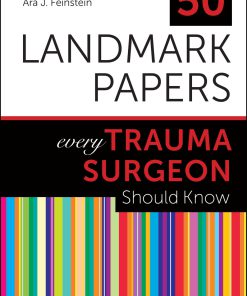Trauma Resilience and Health Promotion in LGBT Patients What Every Healthcare Provider Should Know 1st Edition by Kristen Eckstrand 3319545078 9783319545073
$50.00 Original price was: $50.00.$25.00Current price is: $25.00.
Trauma Resilience and Health Promotion in LGBT Patients What Every Healthcare Provider Should Know 1st Edition by Kristen L. Eckstrand – Ebook PDF Instant Download/DeliveryISBN: 3319545078, 9783319545073
Full download Trauma Resilience and Health Promotion in LGBT Patients What Every Healthcare Provider Should Know 1st Edition after payment.

Product details:
ISBN-10 : 3319545078
ISBN-13 : 9783319545073
Author: Kristen L. Eckstrand
This book has two goals: to educate healthcare professionals about the effect of identity-based adversity on the health of their LGBT patients, and to outline how providers can use the clinical encounter to promote LGBT patients’ resilience in the face of adversity and thereby facilitate recovery. Toward this end, it addresses trauma in LGBT populations; factors that contribute to resilience both across the lifespan and in specific groups; and strategies for promoting resilience in clinical practice. Each chapter includes a case scenario with discussion questions and practice points that highlight critical clinical best practices. The editors and contributors are respected experts on the health of LGBT people, and the book will be a “first of its kind” resource for all clinicians who wish to become better educated about, and provide high quality healthcare to, their LGBT patients.
Trauma Resilience and Health Promotion in LGBT Patients What Every Healthcare Provider Should Know 1st Table of contents:
Part I: Overview of Trauma in LGBT Populations
Chapter 1: Intersection of Trauma and Identity
Traumatic Versus Non-traumatic Events
Minority Stress
Developmental Impact of Homophobia and Transphobia
PTSD Among LGBT Individuals
Non-traumatic Events and PTSD-Like Disorder
Conclusion
Case
Discussion Questions
Summary Practice Points
Resources
References
Chapter 2: Medical Intervention and LGBT People: A Brief History
Introduction
Nineteenth and Early Twentieth Century
WWII and Beyond: The Era of Medical Intervention
1960s-1990s: Civil Rights in a Changing Political Era
Current Issues in LGBT Medicine
Health Inequities
Sexual Orientation Change Efforts
Trans Issues
Conclusion
Resources
References
Chapter 3: Conceptualizing Trauma in Clinical Settings: Iatrogenic Harm and Bias
Defining Trauma
What Do We Know About Trauma and Experiences of LGBT People in Healthcare?
Theoretical Approaches to Understanding and Addressing Trauma with LGBT Patients
Trauma-Informed Care for LGBT People
Identifying Trauma
Addressing Implicit Bias
Reducing Reactivity
Preventing Harm to LGBT People in Healthcare Settings
Promoting Resilience
Advocacy on Behalf of LGBT People in Clinical Settings
Clinical Scenario
Discussion Questions
Summary Practice Points
Resources
References
Chapter 4: Impact of Stress and Strain on Current LGBT Health Disparities
Introduction
Biological Stress
Life Cycle Model of Stress
Reactive Cortisol
Diurnal Cortisol
Allostasis and Allostatic Load
Clinical Allostatic Load Index
Psychosocial Implications and Clinical Perspectives
Social Policy Implications
Case Scenario
Discussion Questions
Summary Practice Points
References
Part II: Resilience Across the Lifespan
Chapter 5: The Role of Resilience and Resilience Characteristics in Health Promotion
Introduction
What Is Resilience and How Does It Develop?
LGBT Resilience Research
LGBT Resilience in the Context of Health Promotion
Conclusions
References
Chapter 6: Childhood and Adolescence
Epidemiology and Healthcare Needs
Diverse Sexual Orientations in Childhood and Adolescence
Diverse Gender Identities in Childhood and Adolescence
The Context of Healthcare for Sexual and Gender Diverse Children and Adolescents: An Affirmative Tra
Health Risks and Vulnerabilities
Identity-Based Stigma, Discrimination, and Victimization
Etiology of Health Risk: A Trauma-Informed Approach
Healthcare for Sexual and Gender Diverse Children and Adolescents
Cultivating Resilience
Understanding Factors that Support Resilience
Information and Communication Technologies
Affirmative Interventions and Programs
Affirmative Healthcare for SGD Children and Adolescents: An Emerging Framework
Articulate Affirmation
Particular Considerations for Gender Diverse Children and Adolescents
Consider Language
Orient to the Setting and Process
Comprehensively Assess for Discrimination and Coping Strategies
Support and Educate Family
Strengthen Organizational Capacity
Case Scenario
Case Description and Presenting Issues
Clinical Considerations
Affirmative Care Approaches
Questions for Learner Discussion
Specific Bulleted Take Home Points
References
Chapter 7: Resilience Across the Life Span: Adulthood
Resilience Resulting from Minority Stressors
General Strengths Using a Positive Psychology Framework
Coming Out Growth
Interpersonal Factors Implicated in Resilience
Individual Difference Factors Implicated in Resilience
Resilience Against Suicidality
Emerging Data
Resilience Promotion in Patient/Provider Relationships
Summary
Case Scenario
Discussion Questions
Summary Practice Points
Resources
References
Chapter 8: Older Adults
Understanding the Context and Impact of Trauma
Sources of External Trauma
Sources of Internal Trauma
Supporting Resilience When Working with LGBT Older Adults
Health Promotion
Case Study
Discussion Questions
Summary Practice Points
References
Part III: Resilience in Specific Populations
Chapter 9: Transgender and Gender Nonconforming Individuals
Introduction
Health Outcomes for Transgender People
Studies of Resilience in Transgender Populations
Summary
Case Scenario
Discussion Questions
Summary Practice Points
Resources
References
Chapter 10: Understanding Trauma and Supporting Resilience with LGBT People of Color
Conceptual Frameworks with LGBT People of Color
Trauma Prevalence Among LGBT People of Color
Terms Used by LGBT People of Color Communities
Coming Out to Others
Access to Services
LGBT People of Color and Religious/Spiritual Beliefs
Individual and Collective Resilience of LGBT People of Color
Adaptive Resilience and Coping Strategies
Collective and Community Resilience
Supporting LGBT People of Color as a Healthcare Provider
Clinical Scenario
Discussion Questions
Summary Practice Points
References to Support Case
References
Chapter 11: LGBT Forced Migrants
Forced Migrants
Terms and Definitions
Seeking Immigration Status in the USA
Forced Migrant Mental Health
LGBT Forced Migrants
Immigration Status for LGBT Forced Migrants
LGBT Forced Migrant Mental Health
Resilience Among Forced Migrants
Providing Services to LGBT Forced Migrants
General Considerations
Medical Assessment
Mental Health Assessment
Mental Health Interventions
Case Example
Discussion Questions
Summary Practice Points
References
Chapter 12: Lesbian and Bisexual Women
Introduction
Minority Stress Model
Development of Coping Mechanisms
Health Disparities in Lesbian and Bisexual Women
Resilience Factors in Lesbian and Bisexual Women
Social Ecological Model
Individual Level
Coming Out
Self-Acceptance
Interpersonal Level
Family of Origin Support
Peer Support
Marriage/Recognized Intimate Relationships
Organization/Community Level
Healthcare Systems
Employment/Workplace
Religion/Spirituality
Community Support Structures
Policy Level
Marriage Equality and Health Outcomes: Impact of Obergefell v. Hodges
Nondiscrimination Policies and Hate Crime Legislation
Bullying as a Health Risk
Promoting Resilience in Lesbian and Bisexual Women
Caring for Self
Caring for Others
Building Families
Bisexual Pride
Conclusion
Case Scenario
Discussion Questions
Summary Practice Points
Resources
References
Chapter 13: Institutionalization and Incarceration of LGBT Individuals
Drivers of Incarceration/Institutionalization
Pathologization of LGBT and GNC Status
Effect of Pathologization
Events Over Time
The Shift from Mental Health Hospitals to Incarceration
Cost for Families and Communities
Dual Diagnosis with Substance Use Disorders
The Current State of Mental Healthcare
Community-Based Mental Health Services
Institutions for the Mentally Ill
Criminal Justice System
Incarceration and Mental Health
Prevalence and Impact of Incarceration on LGBT People
Prevalence of Incarceration Among LGBT Individuals
Arrest and Incarceration of LGBT Adults
Juveniles
Specific Health-Related Concerns Relevant to LGBT Inmates
Provision of Medication
Hormone Therapies
Treatment of HIV/AIDS
Housing Policies
Treatment by Correction Staff and Fellow Inmates
Access to Support Systems
Specific Mental Health Issues Among Justice-Involved LGBT Individuals
Increased Levels of Anxiety and Stress
Issues of Self-Esteem
Post-traumatic Stress Disorder
Mental Deterioration
The Future of LGBT Justice-Involved Individuals: Returning to a Public Health Paradigm
Decriminalization of Substance Use and Mental Illness
References
Part IV: Resilience Promotion in Clinical Practice
Chapter 14: An Overview of Trauma-Informed Care
Definitions of TIC
The Origins of Trauma-Informed Care
Toward a Synthesis: Raja´s Pyramid Model of Trauma-Informed Care
The Relationship Between the Neurobiology of Trauma and TIC
TIC and Trauma-Informed Approaches Outside Healthcare
TIC for LGBT Healthcare and the Promotion of Wellness Among LGBT Individuals and Communities
Evidence of the Effectiveness of TIC
Knowledge and Practice Gaps in TIC
TIC, Resilience, and the Limitations of Resilience
Conclusions
References
Chapter 15: Screening and Assessment of Trauma in Clinical Populations
Introduction
Contextualizing Trauma Assessment Based on Sexual Orientation and Gender Identity
Assessment for Trauma
Screening for Trauma
Transition from Screening to Assessment
Detailed Assessment of Trauma Symptoms
Diagnosis of Trauma-Associated Sequelae
Contextualizing Screening and Assessment of Trauma in LGBT Populations
Rationale for Contextualizing
How Is the Assessment of LGBT Patients Similar and Different from Assessment of Their Heterosexual/C
What Specialized Screening and Assessment Considerations Are Relevant for LGBT People of Color?
What Specialized Screening and Assessment Considerations Are Relevant for LGBT Youth?
What Specialized Screening and Assessment Considerations Are Relevant for LGBT Adults?
Assessment of Posttraumatic Growth and Resilience
Conclusion
Key Clinical Recommendations
References
Chapter 16: Patients and Their Bodies: The Physical Exam
Introduction
Performing a Trauma-Informed Physical Exam That Is LGBT-Inclusive
Screen for Trauma
Consider if You Actually Need to Perform the Exam
Consider if There May Be Alternative Procedures to Recommend to or Offer the Patient
Make No Assumptions About Patients´ Preferences and Discuss the Benefits, Potential Harms, and Limi
Before Proceeding with the Exam, Discuss Whether the Patient Desires Any Modifications to the Exam t
Always Obtain Assent Before You Physically Touch or Examine a Patient
During the Exam, Be particularly Mindful of Your Tone and Reactions
Additional Considerations for Patients Who Have Experienced Trauma
Validate the Patient
Be Patient and Focus on Building a Relationship
Brainstorm Additional Ways to Support the Patient
Be Prepared to Handle Dissociation or Distress During the Exam
Debrief After the Exam and Make Sure the Patient Has a Plan for Self-Care After Leaving the Office
Case Example
Discussion Questions
Example Introductory Language to the Physical Exam
Performing a Physical Exam in the Immediate Posttrauma Setting
Special Considerations: Data, Disparities, and Context
Special Considerations: Administrative Issues, Forms, and Interacting with Others Besides the Patien
Special Considerations: Clinical Considerations for Trans Patients
Special Considerations: Patient-Provider Interaction
Conclusion
References
Chapter 17: Motivational Interviewing for LGBT Patients
Origins of Motivation Interviewing in Theories of Behavior Change
Following
Directing
Guiding
Fundamentals of Motivational Interviewing
R: Resist the Righting Reflex
U: Understand the Motivations of Your Patient
L: Listen to Your Patient
E: Empower, Engage, and Encourage Your Patient
Incorporating Motivational Interviewing into Patient-Provider Interactions
Asking
Open vs. Closed Questions
Agenda Setting
Key Techniques to Asking the Right Questions
Listening
Silence
Reflective Listening and Summarizing
Informing
Balancing Asking, Listening, and Informing
Applications of Motivational Interviewing in LGBT Health
Case Study #1
Instructions for Provider (Actor 1)
Instructions for Patient (Actor 2)
Provider Follow-Up Questions
Patient Follow-Up Questions
Case Study #2
Instructions for Provider (Actor 1)
Instructions for Patient (Actor 2)
Provider Follow-Up Questions
Patient Follow-Up Questions
Additional Resources
References
Chapter 18: Promoting Healthy LGBT Interpersonal Relationships
Background
Trauma-Informed Violence Screening and Assessment in Primary Care
Strategies for IPV Screening in Primary Care
IPV Assessment in Primary Care: Universal Education, Routine Inquiry, and Brief Counseling
Behavioral Health
Assessment of IPV
Treatment of Individuals Following IPV
Ongoing Violence
Stabilization of Trauma Symptoms
Metabolizing Trauma
Integrating Trauma
The Violence Recovery Program, Fenway Health
Case Study
References
Chapter 19: Community Responses to Trauma
Purpose
Learning Objectives
Introduction: Linking Interpersonal and Structural Violence in LGBT Communities
Trauma and Resilience in Vulnerable LGBT Populations
Adolescents and Youth
Elders
Members of Faith-Based Communities
Geographically Marginalized Communities
Historical Community-Based Responses to Trauma
Limitations of Community-Led Responses
Innovations in Community-Led Responses to Trauma
Provider Engagement in Existing Community Support Structures
Advocacy Solutions: Ensuring Sustainable Models to Oppose Structural Violence
Conclusion
References
Chapter 20: Resilience Development Among LGBT Health Practitioners
Objectives
Introduction
People also search for Trauma Resilience and Health Promotion in LGBT Patients What Every Healthcare Provider Should Know 1st:
lgbtq health policy
trauma lgbtq
lgbtq+ trauma
lgbt trauma informed care
lgbt trauma
Tags: Trauma Resilience, Health Promotion, LGBT Patients, Healthcare Provider, Kristen Eckstrand
You may also like…
Business & Economics - Investing
Computers - Networking
How Linux Works What Every Superuser Should Know 3rd Edition Brian Ward
Engineering
What Every Engineer Should Know about Reliability and Risk Analysis First Edition Mohammad Modarres
Computers - Applications & Software
What Every Engineer Should Know About Excel Edition Jack P. Holman1351976478 9781351976473
Computers - Networking
Computers - Networking












